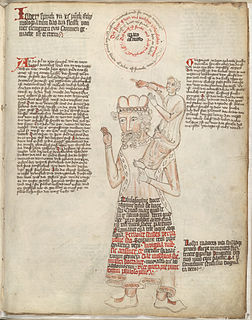 W
W"And yet it moves" or "Albeit it does move" is a phrase attributed to the Italian mathematician, physicist and philosopher Galileo Galilei (1564–1642) in 1633 after being forced to recant his claims that the Earth moves around the Sun, rather than the converse. In this context, the implication of the phrase is: despite his recantation, the Church's proclamations to the contrary, or any other conviction or doctrine of men, the Earth does, in fact, move.
 W
WCarl Edward Sagan was an American astronomer, planetary scientist, cosmologist, astrophysicist, astrobiologist, author, and science communicator. His best known scientific contribution is research on extraterrestrial life, including experimental demonstration of the production of amino acids from basic chemicals by radiation. Sagan assembled the first physical messages sent into space: the Pioneer plaque and the Voyager Golden Record, universal messages that could potentially be understood by any extraterrestrial intelligence that might find them. Sagan argued the now-accepted hypothesis that the high surface temperatures of Venus can be attributed to and calculated using the greenhouse effect.
 W
WIn physics, mass–energy equivalence is the relationship between mass and energy in a system’s rest frame, where the two values differ only by a constant and the units of measurement. The principle is described by Albert Einstein's famous formula:
 W
WApollo 11 was the spaceflight that first landed humans on the Moon. Commander Neil Armstrong and lunar module pilot Buzz Aldrin formed the American crew that landed the Apollo Lunar Module Eagle on July 20, 1969, at 20:17 UTC. Armstrong became the first person to step onto the lunar surface six hours and 39 minutes later on July 21 at 02:56 UTC; Aldrin joined him 19 minutes later. They spent about two and a quarter hours together outside the spacecraft, and they collected 47.5 pounds (21.5 kg) of lunar material to bring back to Earth. Command module pilot Michael Collins flew the Command Module Columbia alone in lunar orbit while they were on the Moon's surface. Armstrong and Aldrin spent 21 hours, 36 minutes on the lunar surface at a site they named Tranquility Base before lifting off to rejoin Columbia in lunar orbit.
 W
WAlbert Einstein's religious views have been widely studied and often misunderstood. Albert Einstein stated that he believed in the pantheistic 'god' of Baruch Spinoza. He did not believe in a personal God who concerns himself with fates and actions of human beings, a view which he described as naïve. He clarified however that, "I am not an atheist", preferring to call himself an agnostic, or a "religious nonbeliever." Einstein also stated he did not believe in life after death, adding "one life is enough for me." He was closely involved in his lifetime with several humanist groups.
 W
WThe phrase "scientia potentia est" is a Latin aphorism meaning "knowledge is power". It is commonly attributed to Sir Francis Bacon, although there is no known occurrence of this precise phrase in Bacon's English or Latin writings. However, the expression "ipsa scientia potestas est" occurs in Bacon's Meditationes Sacrae (1597). The exact phrase "scientia potentia est" was written for the first time in the 1668 version of the work Leviathan by Thomas Hobbes, who was a secretary to Bacon as a young man.
 W
WThomas Augustus Watson was an assistant to Alexander Graham Bell, notably in the invention of the telephone in 1876.
 W
WJ. Robert Oppenheimer was an American theoretical physicist and professor of physics at the University of California, Berkeley. Oppenheimer was the wartime head of the Los Alamos Laboratory and is among those who are credited with being the "father of the atomic bomb" for their role in the Manhattan Project, the World War II undertaking that developed the first nuclear weapons. The first atomic bomb was successfully detonated on July 16, 1945, in the Trinity test in New Mexico. Oppenheimer later remarked that it brought to mind words from the Bhagavad Gita: "Now I am become Death, the destroyer of worlds." In August 1945, the weapons were used in the atomic bombings of Hiroshima and Nagasaki.
 W
WKenneth Tompkins Bainbridge was an American physicist at Harvard University who did work on cyclotron research. His precise measurements of mass differences between nuclear isotopes allowed him to confirm Albert Einstein's mass–energy equivalence concept. He was the Director of the Manhattan Project's Trinity nuclear test, which took place July 16, 1945. Bainbridge described the Trinity explosion as a "foul and awesome display". He remarked to J. Robert Oppenheimer immediately after the test, "Now we are all sons of bitches." This marked the beginning of his dedication to ending the testing of nuclear weapons and to efforts to maintain civilian control of future developments in that field.
 W
WThe phrase "scientia potentia est" is a Latin aphorism meaning "knowledge is power". It is commonly attributed to Sir Francis Bacon, although there is no known occurrence of this precise phrase in Bacon's English or Latin writings. However, the expression "ipsa scientia potestas est" occurs in Bacon's Meditationes Sacrae (1597). The exact phrase "scientia potentia est" was written for the first time in the 1668 version of the work Leviathan by Thomas Hobbes, who was a secretary to Bacon as a young man.
 W
WStanding on the shoulders of giants is a metaphor which means "Using the understanding gained by major thinkers who have gone before in order to make intellectual progress".
 W
WNeil Alden Armstrong was an American astronaut and aeronautical engineer, and the first person to walk on the Moon. He was also a naval aviator, test pilot, and university professor.